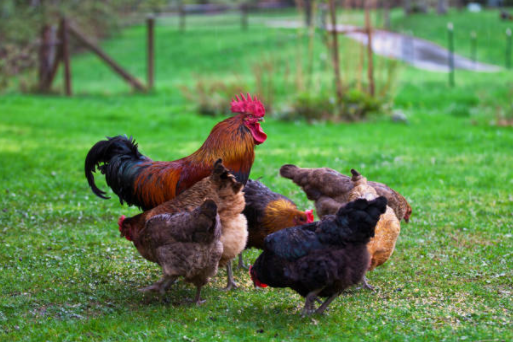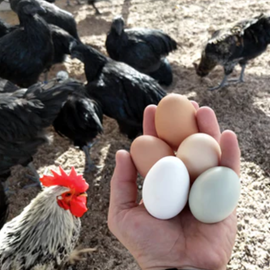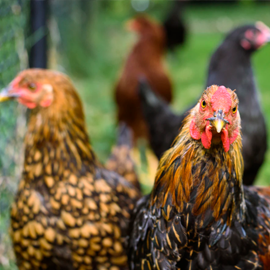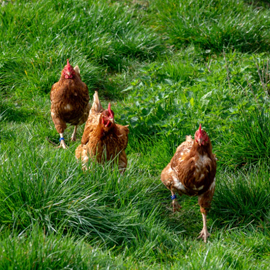 If you're feeling clucky and think it’s time to adopt some chickens, you might want to do a bit of research first. While it would be nice to go and rescue the first chooks that you find down a long, lonely country road, the reality is that there’s a fair bit to know about keeping and raising them.
If you're feeling clucky and think it’s time to adopt some chickens, you might want to do a bit of research first. While it would be nice to go and rescue the first chooks that you find down a long, lonely country road, the reality is that there’s a fair bit to know about keeping and raising them.
One of the first things you need to know is that there are quite a few different breeds of chickens. Like, so many, in fact, that you're going to wonder where even to start. Don't worry – we've got this sorted for you. We thought we would start off with the bantam chicken, so you can figure out if you like them, or if you have to persevere in your search for the perfect brood. Let's take a look at everything you need to know about bantam chickens, and how to take care of them if you decide they're your forever breed.
History of the Bantam Chicken
Let's take a little trip down memory lane to figure out just how the bantam chicken got to be part of the rest of the chicken breeds today. To do so, we’ve got to go to the far-reaching shores of Bantan, Indonesia, for the answer.
When sailors of yore took a little quick break in the ports of Indonesia, namely, Bantan for things like food and drink, they were impressed by the different breed of chickens that they seemed to have. They were smaller, which is mystifying a little bit – why were they stoked they were smaller? We think that it was a space thing – if the chickens were smaller, you could fit more of them into the same space. Either way, the word ‘bantan' was used a little bit for a while before we settled permanently on 'bantam,' which is what they are called today.
Breed Standard and Size, Appearance
So, even though the history of the bantam chicken is relatively straightforward, it gets pretty confusing when you talk about its size and appearance. To be pedantic, there are actually three different types of bantam chicken today.
The first is what’s called the ‘true’ bantam chicken. Within this type of bantam, you’ve got sub-breeds, like Rosecomb, Sebright, and Nankin.
Then, you've got your miniaturized bantams, which is the breed standard, so if you were to drive down that lonely country road and come across some bantams, they would more than likely be these. Within this category, you've got Orphintons, Cochin, and Rhode Island Red.
Lastly, you've got what we call 'developed' bantams. These are the smallest breeds, and they've had a little bit of help with their breeding from us. They've been around for a while as well, so it's pretty difficult at this point to determine exactly where they come from. However, all you need to know are the sub-breeds, which are Japanese, Pekin, and Belgian.
Temperament and Disposition
So, we’ve come to the million-dollar question: what are bantam chickens like? Are they as cool as a cucumber, or do they run red and cause panic amongst the brood just for fun?
We've got good news – for the most part, bantam chickens are super friendly, might even do a little flirting, and overall have really sweet temperaments. They also are said to do really well when interacting with other animals, which is great news if you have a prized pooch or a furry feline that is going to take some buttering up to win over. They're generally great with humans, too, so if you've always wanted the kind of chooks that want to cuddle up with you on the couch, you could be onto a winner here.
Now, we can’t talk about the temperament and disposition of the bantam chicken without talking about mating season. They all go through it, and most of them come out the other side relatively unscathed – but you’ve got to know what you’re getting yourself into nonetheless. The roosters can be a bit pecky and territorial throughout this particular season, but other than this, you shouldn't run into any issues.
Another thing you need to know about bantam chickens is that they’re adventurers. They love to mosey on around, and they are pretty agile, so don’t worry about having to rescue them from tight, uncompromising places.
How to Raise and Care for Your Bantam Chicken
One of the first things you need to know about bantam chickens is not to be fooled by their small appearance – these guys have a huge appetite, and they're going to let you know about it as often as they can. In fact, it's because they are small that they are so hungry all the time. Don't worry, though – while they might always be pecking at the door for food when they do eat, it won't be as much as larger breeds.
If you've done a bit of looking around already, one thing you might know about most chicken breeds is that they either love the cold, or they absolutely hate it. This all comes down to the size of their coat – obviously, the bigger their coat, the less complaining they'll do. The somewhat bad news is that bantam chickens don't love the cold, and some sub-breeds are fare terribly in the colder months. If you live somewhere that gets cold in the winter, we don't recommend picking the Japanese or Dutch breeds.
If you want to get your DIY on, though, you can build – or buy – a warm, dry chicken coop that they can use all year round, without getting too jittery from the wind. One massive advantage that the sailors knew before anyone else is that you'll need less space to raise bantams, with each chook only needing one to two square feet of space in their coop, and four in their run.
Bantams are smaller, and they're a bit stumpier, too. Their shorter legs are going to get them around the place just fine, but they might also trip them up if they’ve got a high perch. Make sure that you lower that perch. However, just to keep things interesting, some bantams do prefer high perches, so make sure to read up about the exact breed you’re going for before you buy all the stuff.
Because these guys are small, they’re usually the underdog in a cockfight. While we know you’re not actually going to pit your chooks against each other, you might want to be wary of raising different breeds together. While this can work for the most part, just remember to consider the bantams before you throw them in the cage with anything else – they’ll most likely be the smallest guys in there.
Benefits and Drawbacks
Who doesn’t raise a fuss from time to time? Bantams, even though they’re one of the more docile chicken breeds, can be tough from time to time – but they can also be great. All chicken breeds out there come with their advantages and disadvantages, so let’s take a look at some of these.
Advantages
So, remember when we talked about their appetite and all that, but then brought a little bit of light to this information by telling you that they actually eat less overall? This means that they’re actually a lot less expensive to keep – and they produce less waste as well. Because they take up less space, less feed, and less of your wallet, they’re actually a great option if you live somewhere that’s relatively urban, and don’t have a large lifestyle block to work with.
Bantam chickens are also the kind of pets you want at your child's birthday party – because they're super docile and great with kids. They are super easy-going and like to have fun as well, making them a great choice if you've got young ones running around.
Bantams aren’t usually raised for their meat, but they are for their eggs. They produce a lot, but they’re slightly smaller than regular-sized eggs. What’s more, they’re great mothers and get broody a lot, which means that you don’t have to invest in an artificial chicken – an incubator – to breed more of them. Last advantage? They’re quieter than other chooks. This is another massive advantage if you want to keep the peace in the neighborhood for as long as possible.
Disadvantages
How are your neighbors with finding a rogue chicken in their backyard? If you don’t think they’ll be pleased to discover a couple of your brood, then you might want to consider this when thinking about getting bantams. Bantams are agile and mobile, and they love to look further afield for their foraging. They can also easily fly over standard fences, so keep this in mind when you think you’re thinking about getting a few. You might want to adjust fences and make sure that they’ve got an enclosed, safe space to be.
Another reason why this is a downside – it leaves them vulnerable to pesky predators that might be lurking in your garden either during the day or at night. The roosters aren’t known at being great at protecting the brood as well, so you’re going to have to be pretty careful to make sure they’ve got a danger-proof home to snuggle into.
Bantam chickens also aren’t the best if you’re trying to beat the local record for the most eggs produced in an urban neighborhood. You’re better to go for a regular chicken breed if having fresh eggs every day for breakfast is by far and large your biggest priority.
Are Bantam Chickens Right for You?
Has it been your dream since you were a kid to own a chicken, more for pet purposes than anything else? Then you need to seriously consider investing in a brood of bantams. However, if you want a chicken that’s going to sit in their coop day in and day out and lay a record-breaking number of eggs for you, they’re probably not your best choice.
However, if you don’t really care about this, and just want the company, then they are the ultimate backyard bird of choice. Remember, too, that they’re great for your wallet, as well, so they’ll quietly become part of the family without breaking the bank too much.








